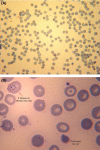G6PD deficiency: a classic example of pharmacogenetics with on-going clinical implications
- PMID: 24372186
- PMCID: PMC4153881
- DOI: 10.1111/bjh.12665
G6PD deficiency: a classic example of pharmacogenetics with on-going clinical implications
Abstract
That primaquine and other drugs can trigger acute haemolytic anaemia in subjects who have an inherited mutation of the glucose 6-phosphate dehydrogenase (G6PD) gene has been known for over half a century: however, these events still occur, because when giving the drug either the G6PD status of a person is not known, or the risk of this potentially life-threatening complication is under-estimated. Here we review briefly the genetic basis of G6PD deficiency, and then the pathophysiology and the clinical features of drug-induced haemolysis; we also update the list of potentially haemolytic drugs (which includes rasburicase). It is now clear that it is not good practice to give one of these drugs before testing a person for his/her G6PD status, especially in populations in whom G6PD deficiency is common. We discuss therefore how G6PD testing can be done reconciling safety with cost; this is once again becoming of public health importance, as more countries are moving along the pathway of malaria elimination, that might require mass administration of primaquine. Finally, we sketch the triangular relationship between malaria, antimalarials such as primaquine, and G6PD deficiency: which is to some extent protective against malaria, but also a genetically determined hazard when taking primaquine.
Keywords: Clinical Implications; G6PD; pharmacogenetics.
© 2013 John Wiley & Sons Ltd.
Figures





References
-
- Adam A. Linkage between deficiency of glucose 6-phosphate dehydrogenase and colour-blindness. Nature. 1961;189:686–688. - PubMed
-
- Alloueche A, Bailey W, Barton S, Bwika J, Chimpeni P, Falade CO, Fehintola FA, Horton J, Jaffar S, Kanyok T, Kremsner PG, Kublin JG, Lang T, Missinou MA, Mkandala C, Oduola AM, Premji Z, Robertson L, Sowunmi A, Ward SA. Winstanley PA. Comparison of chlorproguanil-dapsone with sulfadoxine-pyrimethamine for the treatment of uncomplicated falciparum malaria in young African children: double-blind randomised controlled trial. Lancet. 2004;363:1843–1848. - PubMed
-
- Bain BJ. A ghostly presence-G6PD deficiency. American Journal of Hematology. 2010;85:271. - PubMed
-
- Balaka B, Balaka B, Agbere D, Bonkoungou P, Gnamey D, Kessie K. Assimadi K. Post-hemolytic renal failure in children with glucose-6-phosphate dehydrogenase deficiency at the University Hospital Center in Lome. Medecine Tropicale: Revue Du Crops De Santé Colonial. 2003;63:151–154. - PubMed
Publication types
MeSH terms
Substances
LinkOut - more resources
Full Text Sources
Other Literature Sources
Medical
Miscellaneous

